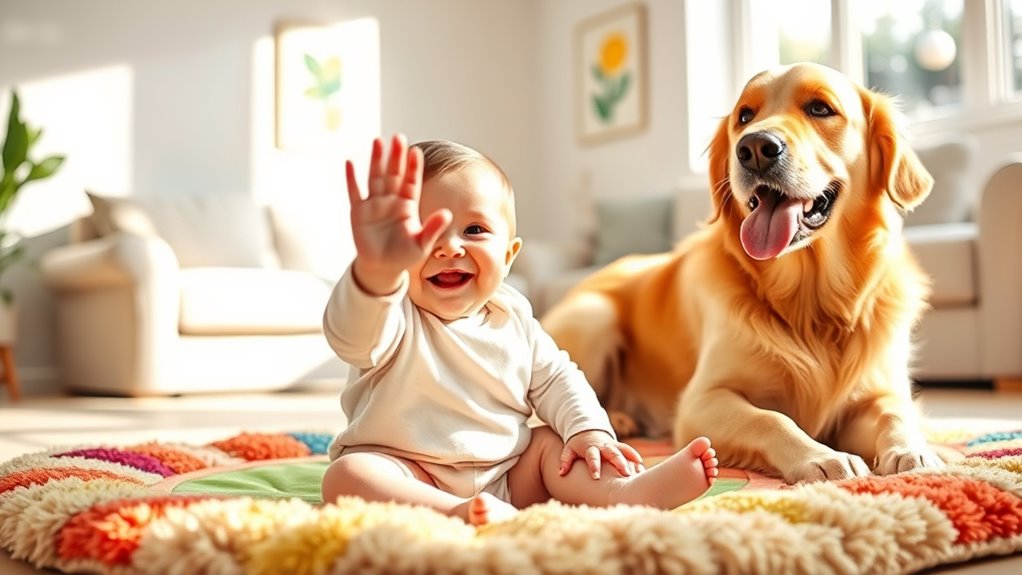To teach your baby to wave, start by demonstrating the action yourself. Hold their hand and move it in a waving motion. Regularly say hello and goodbye while waving, helping them connect the gesture with its meaning. Practice in front of a mirror for visual feedback. Use playful activities, like songs with hand gestures or playing with dolls, to make it fun. With repeated encouragement and positive reinforcement, they’ll soon grasp this social skill. There’s more to explore about boosting their waving confidence!
Key Takeaways
- Physically demonstrate waving by moving your hand in a waving motion while saying “hello” or “goodbye.”
- Hold your baby’s hand and guide it to wave, reinforcing the action through repetition.
- Use a mirror to practice waving, allowing your baby to see their own movements for better understanding.
- Integrate waving into daily routines, consistently waving when entering or leaving a room to encourage imitation.
- Celebrate their attempts to wave with positive reinforcement to boost their confidence and motivation.

Teaching your baby to wave can be a delightful milestone to share, typically happening between 7 and 12 months. This simple gesture not only showcases their growing abilities but also marks their development in communication and social interaction. Waving is an early form of expressing greetings or farewells, and it requires a mix of cognitive, motor, and social skills. You’ll find that as your baby starts to comprehend the meaning behind this gesture, their eagerness to imitate will increase.
To encourage your baby to wave, start by demonstrating the action. You can gently hold their hand and move it in a waving motion. This physical guidance helps them associate the movement with the gesture’s meaning. Whenever you enter or leave a room, make it a habit to wave hello and goodbye. This repetition reinforces recognition and encourages imitation. You might also practice in front of a mirror. Babies love visual feedback, and seeing themselves wave can boost their confidence and understanding of the gesture.
Encourage your baby to wave by demonstrating the action and practicing together, reinforcing their understanding and confidence.
Integrating songs with hand gestures into your daily routine is another fantastic way to promote waving. These playful activities not only enhance motor skills but also make learning fun. Engaging in play with dolls or stuffed animals can also provide excellent opportunities for practicing waving in a low-pressure environment. Just remember, waving is a skill that develops over time, starting with simple movements and refining into more coordinated actions.
As your baby grows, their social skills will blossom, and waving will become a crucial component of their interactions. Babies learn by observing and mimicking those around them. By regularly modeling waving in a variety of contexts, you’ll help them understand its significance. Positive reinforcement is key; when they attempt to wave, cheer them on! This encouragement will boost their confidence and motivate them to try again.
Cognitive development plays a vital role in this process. Your baby needs to grasp the meaning of waving within social contexts to fully embrace it. Imitation is a fundamental cognitive skill that helps them learn gestures, and the more they see others wave, the more likely they’re to do it themselves.
Most babies will make their first attempts at waving around 7 months, with many mastering the gesture by their first birthday. So, enjoy this special time! With your support and encouragement, your little one will soon be waving hello and goodbye with joy.
Frequently Asked Questions
At What Age Do Babies Typically Start Waving?
Babies typically start waving between 6 and 9 months, although some might begin as early as 6 months or as late as 14 months.
By around 11 months, most are excited by the social experience of greeting others.
You’ll notice their hand-eye coordination improving, and they may imitate gestures they see.
Waving is an important milestone in their development, signaling emerging social skills and communication.
Keep an eye on their progress during check-ups!
Can I Use Toys to Encourage Waving?
Absolutely, toys can be your secret weapon in encouraging waving! They’re like magic wands that spark your baby’s interest and mimicry.
By using colorful, engaging toys, you’ll capture their attention and inspire them to imitate your waving. Incorporate sensory toys, mirrors, and even musical ones during playtime to create a fun atmosphere.
Consistency is key, so make waving a regular part of your routine, and soon you’ll see those tiny hands waving back!
What if My Baby Doesn’t Wave at All?
If your baby doesn’t wave at all, it’s important to stay calm.
Every child develops at their own pace, and missing this milestone isn’t always a cause for concern.
Keep an eye on other developmental skills, and if you notice delays in multiple areas, consider consulting your pediatrician.
They can assess your child’s overall development and provide guidance.
Should I Be Concerned About My Baby’s Motor Skills?
Should you be concerned about your baby’s motor skills?
It’s normal to worry if they’re not hitting milestones like rolling or sitting up. If your baby isn’t rolling by 6 months or sitting independently by 7 months, it might be time to talk to a pediatrician.
Regular tummy time and play can boost their strength and coordination.
How Can I Reinforce Waving During Playtime?
To reinforce waving during playtime, consistently model the gesture yourself.
Use clear demonstrations when greeting or saying goodbye, and incorporate waving into daily routines.
Engage your baby with interactive games like peek-a-boo, where waving can be part of the fun.
Encourage their attempts by praising and responding to their gestures.
Conclusion
Teaching your baby to wave is a joyful journey, blending patience with excitement. While it might feel like a slow dance at first, each little attempt brings you closer to that triumphant moment when they greet the world with a wave. Embrace the giggles and the awkward flails, for they’re part of the learning process. Soon, you’ll cherish those sweet waves that turn into enthusiastic hellos, transforming simple gestures into beautiful connections with those around them.









